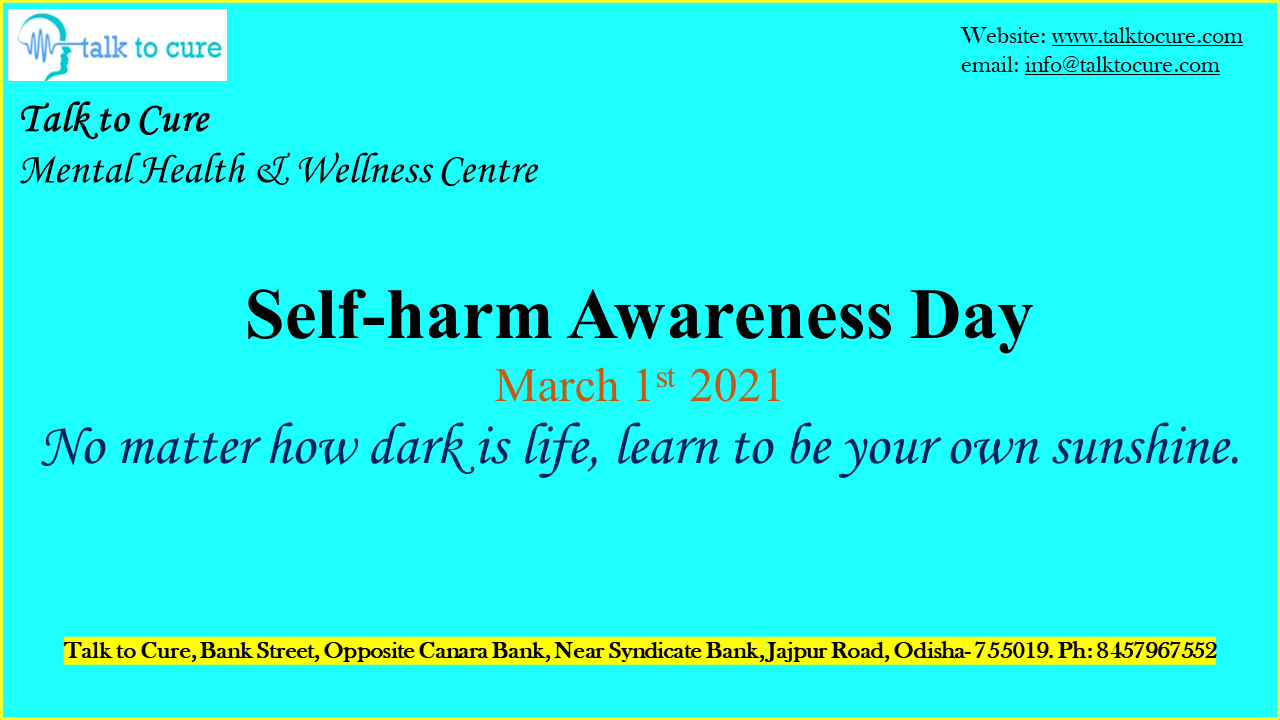SELF-HARM AWARENESS: LEARN TO FIGHT BACK

Self-injury or Self-harm awareness day is a global event which is observed on March 1st every year. Self-harm can be defined as an intentional attempt or act of hurting oneself (majorly as an emotional coping mechanism). It is less likely that a person who engages in self harm intend to commit suicide; however, continuous acts of self-harm may result in loss of life if not treated on time and the individual does not receive required emotional support. Self-harming acts are performed by various means such as:
- Cutting oneself with sharp objects like, razor blades, knives etc.
- Punching oneself with own hands or banging on walls
- Burning oneself with hot objects, cigarettes, etc.
- Pulling out hair
- Poking into the skin
- Carving on the skin
- Self-Bruising
- Hitting oneself hard to the level that leads to bone breakage
Self-harming may not be categorized under any psychiatric disorder, rather, it is an unhealthy way of dealing and coping with intense emotions. Usually, individuals who engage in such acts unconsciously exhibit signs of needing emotional support and psychological help, they find it effective to deal with feelings of emptiness and numbness, the pain caused by self-harm allows them to feel and sense, it is also a way for them to cut off from unpleasant events and memories, they release tension and intense emotional feelings through self-harm and gain a sense of control over themselves.
As mentioned earlier, self-harming is not a disorder; however, it definitely represents underlying psychological issues. Though there is no specific age or gender, to which such behaviors belong, but they usually start during teenage or early adulthood. It is possible that behaviors occurring at these ages have a root in the childhood. There can be variety of factors leading to this condition like early childhood trauma, any type of abuse, post traumatic stress, certain personality characteristics, excessive use of substances, and a circle that engages in such acts etc.
Individuals who engage in self-harming behaviors exhibit signs that can be observed by others such as:
- Injury marks (usually unexplained)
- A relatively set pattern of scars on the body
- Always having fresh injury marks in the forms of cuts, bruises, bite marks etc.
- Wearing full coverage clothes even in hot weather (usually to hide injuries or scars)
- Always explaining injuries as accidental
- Almost always keep sharp/injurious objects handy
These signs cannot be the only parameters of self-harming acts; however, if any one displays such signs along with difficulty in maintaining interpersonal relationships, emotional instability, unpredictable behaviors, withdrawn behaviors, using statements related to worthlessness, hopelessness etc., it must be observed carefully and professional advice should be considered. If professional advice is delayed or neglected, such conditions may have serious outcomes and lead to complications like worsening of the wounds, possibility of infection spreading to other body parts, chances of injury which is severe enough to be fatal.
It is difficult to deal with distressing emotions and its okay to feel anxious when something is not on track. But people with poor coping ability tend to resort to unhealthy behaviors to deal with the distressful situations. It is difficult to come up with a definite solution to this problem; however, trying to figure out the best possible way to deal with it is definitely an option. As community, we all need to come forward to help individuals who might be in need for help. Following are some of the things that can be followed as a preventive measure:
- Be observant: To offer help to others, its important to be observant for the emotional and behavioral signs of distress and self-injurious behaviors. If the person seems to be on risk advise them to seek professional help.
- Motivate: Usually people who engage in self-injurious behaviors suffer from low self-esteem. In such conditions, boosting their moral is very important. Motivate them to believe in themselves and provide enough emotional support.
- Make them aware: Help them learn about the warning signs and circumstances that could trigger self-injurious behaviors. Make them aware about mental health care facilities that could help.
- Networking: Individuals who surrender in emotionally vulnerable circumstances need a support network to be available for them in times of need. Help them build a network that could be available for them whenever they need it. This network could be a group of people who themselves suffered and fought well with their issues, or people who are ready to extend emotional support and just be present with the person till the urge to self-harm passes.
- Professional Help: Individuals who self-harm needs professional guidance to learn about healthy ways to cope with highly distressful feelings. Professional guidance can make the condition much better and make those individuals much resilient. Help them find a mental health professional and refer them to adequate facilities available around.
Mental health professionals have been seeing and dealing with such cases since a long time. There have been continuous efforts to develop effective management programs that help individuals with self-harming behaviors to develop better understanding of their triggers and manage them effectively in a healthy way.
If you have any query related to this article or any other mental health issue feel free to write us back at info@talktocure.com.
Neelam Verma
Clinical Psychologist
Talk to cure
